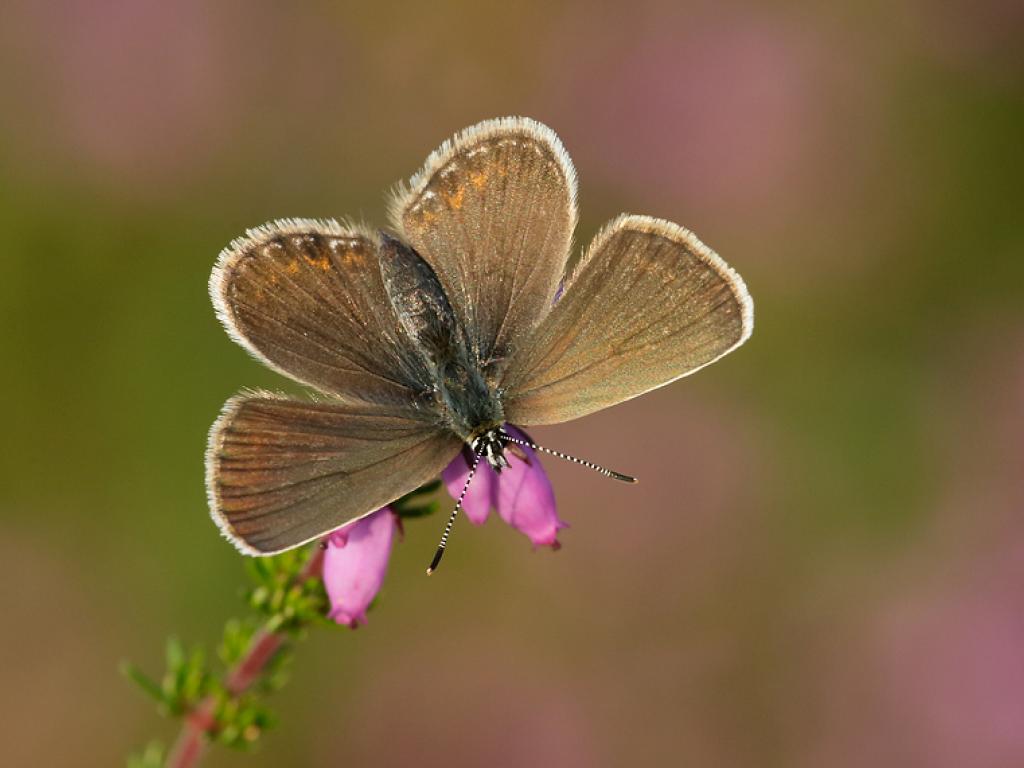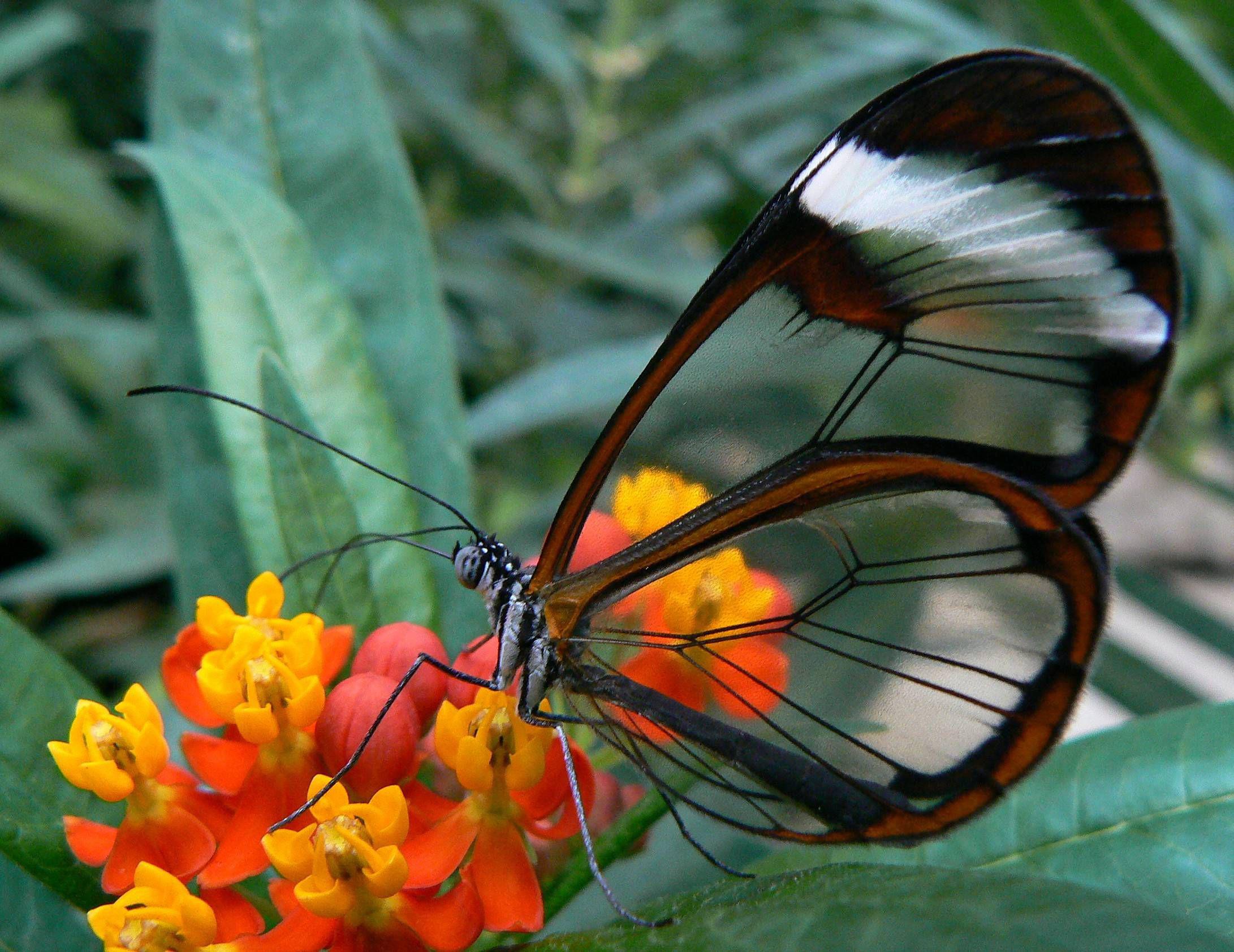Size and Family
- Family: Blues
- Size: Small
- Wing Span Range (male to female): 29-31mm
Conservation Status
- Butterfly Conservation: Medium
- Section 41 species of principal importance under the NERC Act in England
- Listed on Section 7 of the Environment (Wales) Act 2016
- UK BAP status: Priority Species
- Protected under Schedule 5 of the 1981 Wildlife and Countryside Act (for sale only)
- European status: Not threatened
Caterpillar Foodplants
A wide variety of ericaceous and leguminous plants are used: on heathland, the most common are Heather (Calluna vulgaris), Bell Heather (Erica cinerea), Cross-leaved Heath (E. tetralix), gorses (Ulex spp).
Males blue with a dark border. Females brown with a row of red spots. Undersides brown-grey with black spots, a row of orange spots, and small greenish flecks on outer margin. Males are similar to Common Blue, which lacks greenish spots.
This small butterfly is found mainly in heathland where the silvery-blue wings of the males provide a marvellous sight as they fly low over the heather. The females are brown and far less conspicuous but, like the male, have distinct metallic spots on the hindwing. In the late afternoon the adults often congregate to roost on sheltered bushes or grass tussocks.
The Silver-studded Blue has a restricted distribution but occurs in large numbers in suitable heathland and coastal habitats. It has undergone a major decline through most of its range.
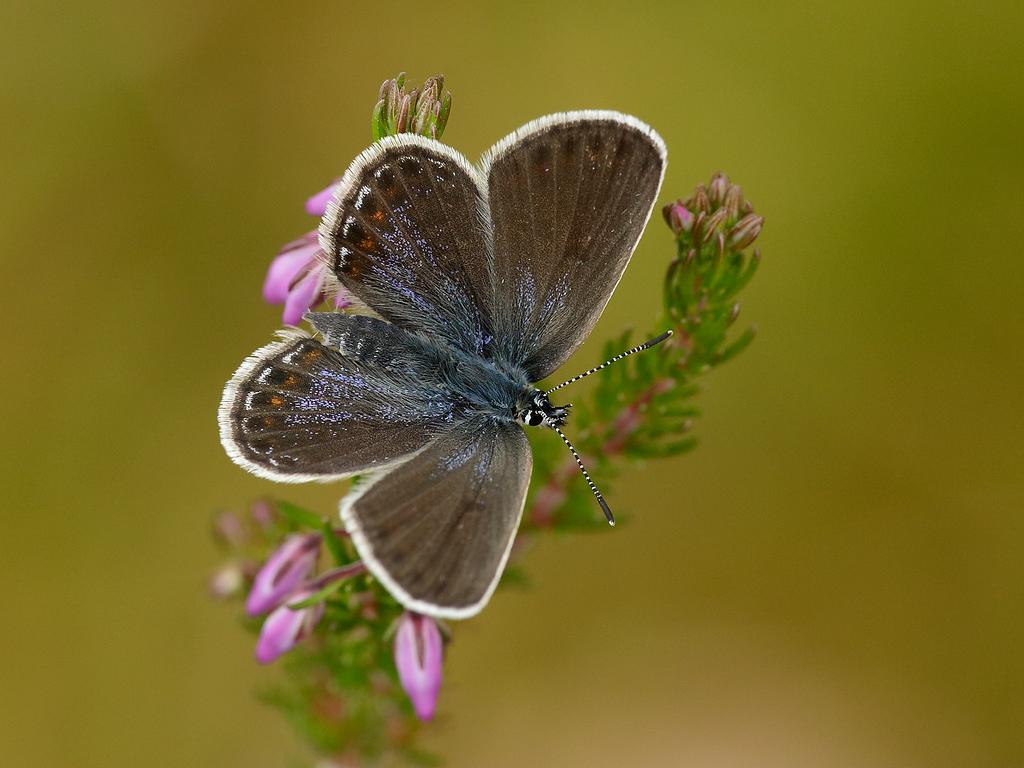
The Silver-studded Blue butterfly (Plebejus argus) is a rare and fascinating species with some unique characteristics. Here are key facts about its predators, habitat, diet, and life cycle:
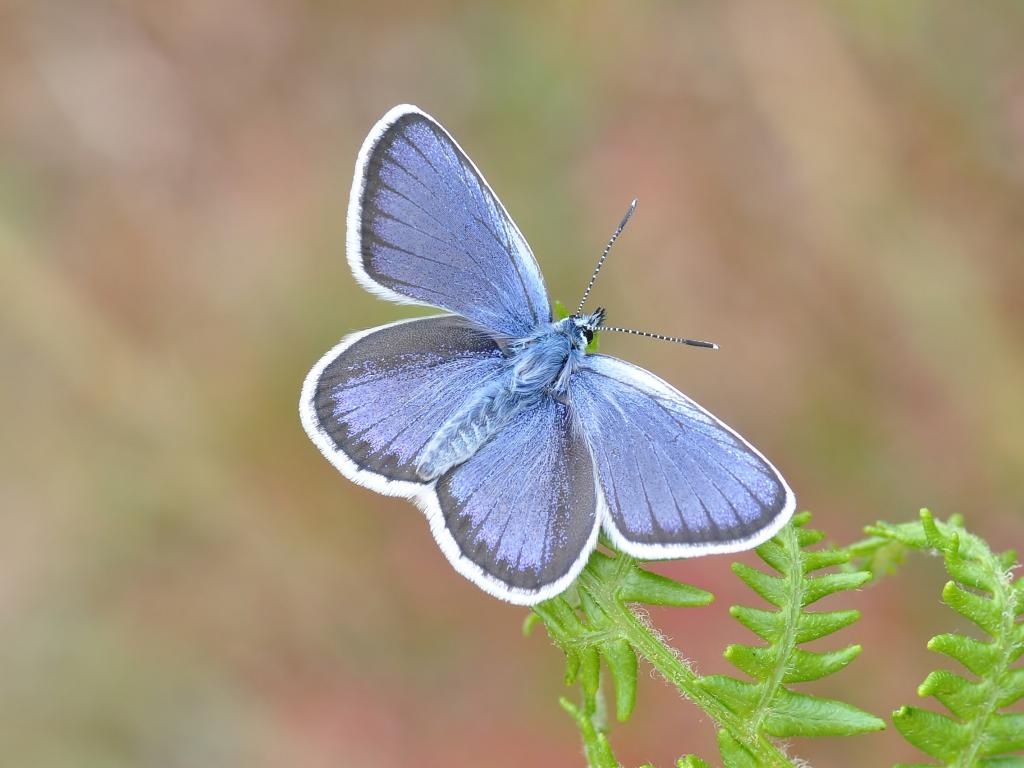
Habitat
The Silver-studded Blue is primarily found in:
It prefers open areas with short vegetation (2-7 cm tall) and some bare ground. The butterfly is highly habitat-specific, which contributes to its restricted distribution mainly in southern England, with some populations in Wales and eastern England.
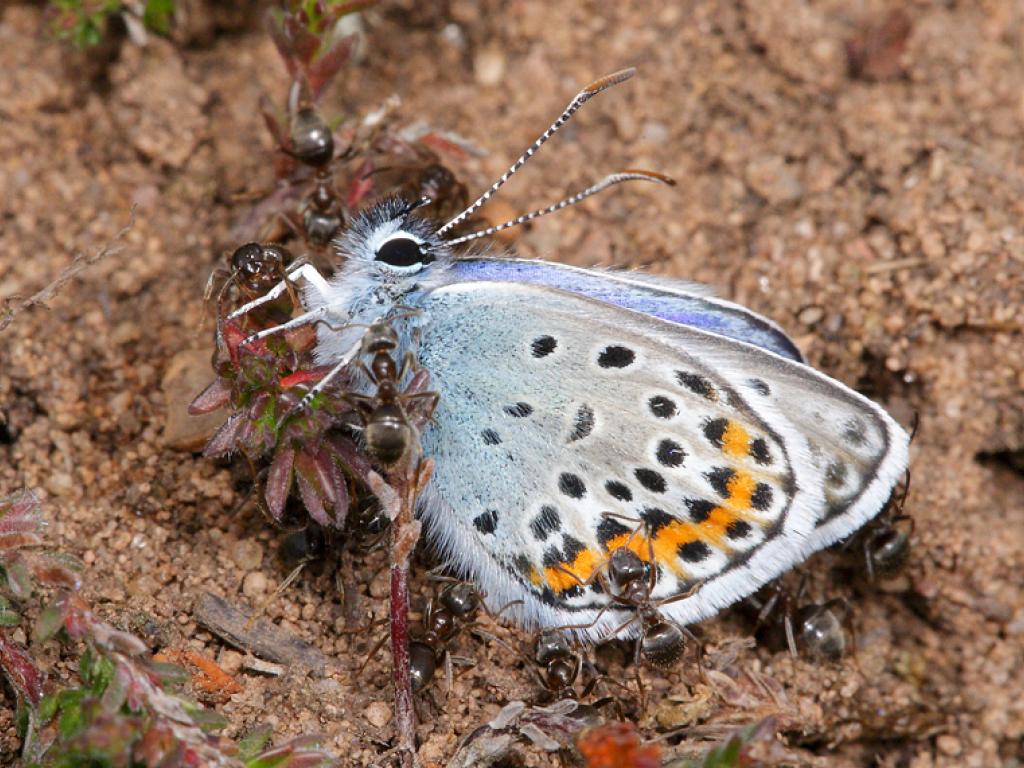
A rare butterfly found on heathland, sand dunes and chalk/limestone grassland.
Heathlands are able to meet the needs of P. argus due to burning, cutting, and other disruptions of mature heaths.With these disruptions, the habitat becomes conducive to habitation by P. argus because of the high cover of E. cinerea and short C. vulgaris that is able to form a landscape with the patches of bare ground. This is characteristic of heathland at an early stage of development. This environment is suitable until the point at which the shrubs native to the environment mature and obscure the bare ground and vegetation margins that the butterflies use for oviposition.
Mossland, similar in nature to wet heathland, has soil primarily composed of peat which supports one of the families of host plants of P. argus, Ericaceae. This host plant grows alongside other grasses, sedges, and rushes. While the main disturbance to heathland is quarrying, mossland faces peat digging which contributes to the transient and shifting nature of this particular habitat.
The hostplants of the first two environments, Ericaceae and Leguminosae, are less present in the third environment, limestone grassland. In this environment, the host plants of P. argus are primarily herbaceous Cistaceae as well as Leguminosae.In limestone grassland, the bare ground and vegetation margins instrumental to the life cycle of P. argus are created through grazing by other animals as well as by disruption of the habitat by natural disturbance of the stoney topography of this environment.
P. argus use shrubs for roosting, resting, basking, mate location, and shelter and for this reason, they tend to be found in higher numbers close to locations that are dense in shrubs. Most of the population gathers around these shrubs during weather that is colder, cloudy, and windier. When the weather is warm, sunny, and the breeze is still, P. argus spends less time in shrub dense habitats and more time in flight and finding host plants in areas rich in calcareous heath. These areas tend to be on exposed hillsides. For this reason, it often appears that the habitat of P. argus shifts with weather conditions.
In addition to choice of habitat due to host plants and topography, P. argus density correlates with the densities of nest of the butterflies’ mutualist ants, Lasius niger and Lasius alienus.
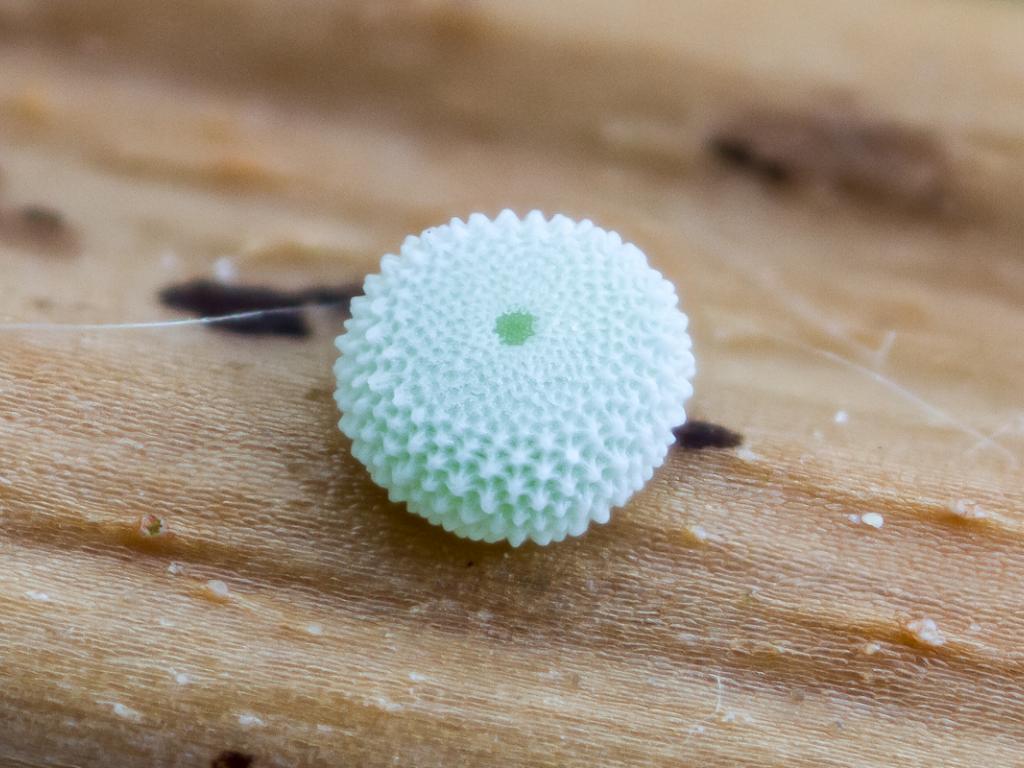
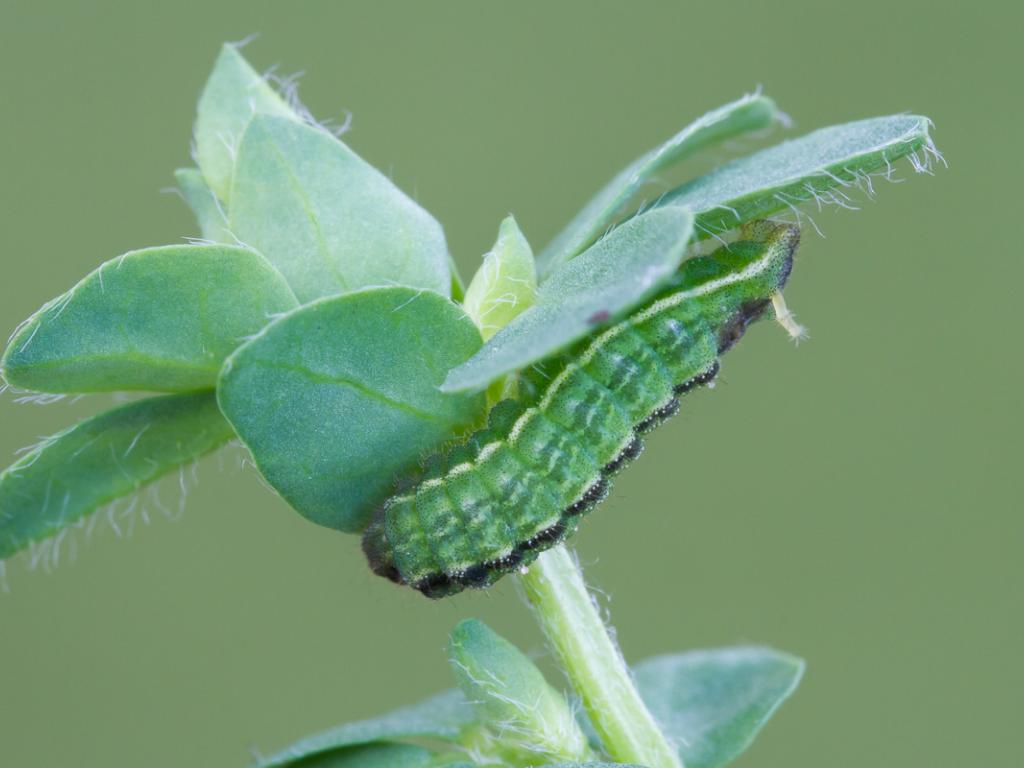
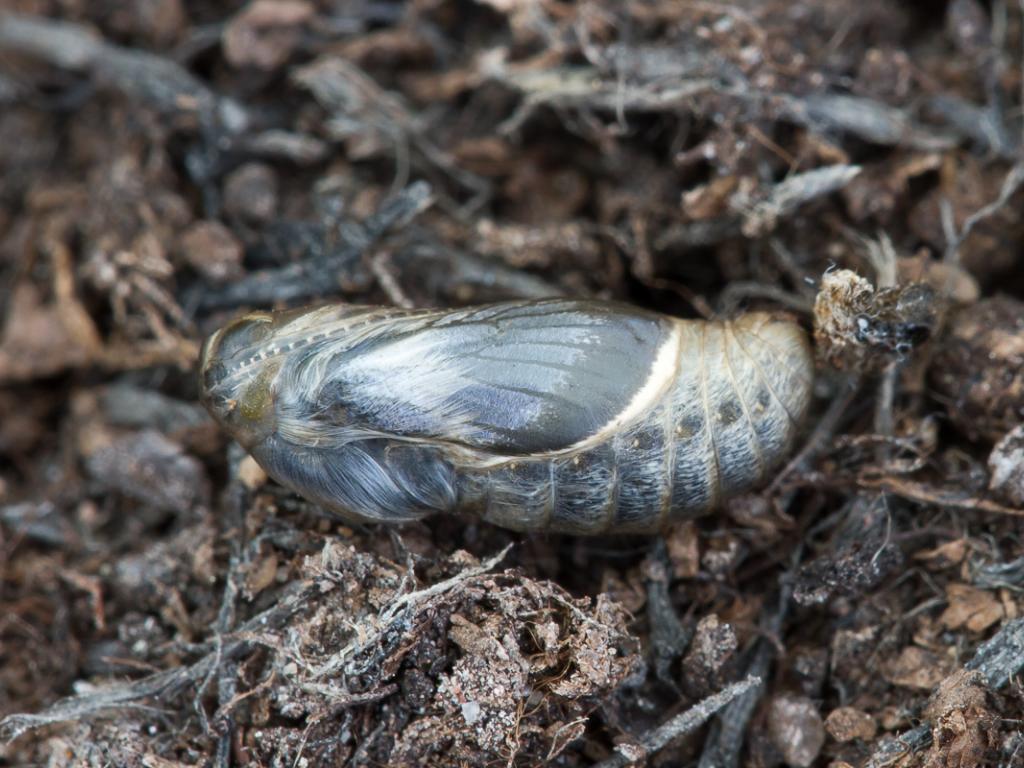
Diet
The caterpillars feed on:
- Heather (Calluna vulgaris)
- Bell Heather (Erica cinerea)
- Cross-leaved Heath (Erica tetralix)
- Gorse species (Ulex spp.)
On sand dunes, caterpillars may eat Bird’s-foot Trefoil. Adult butterflies feed on nectar from various flowers found in their habitats.
Life Cycle
The Silver-studded Blue has a fascinating life cycle:The life cycles of Plebejus argus are divided into four main stages: eggs, larvae, pupa, and adults.
Most colonies start to emerge in the middle of June flying into the first part of July and even early August, although the caernensis subspecies found on the Great Orme emerge earlier, typically at the end of May and start of June, flying throughout June and into the start of July. There is one brood each year.
- Eggs: Laid singly close to the ground in July-August, overwintering in this stage.Egg guarding primarily occurs through mutualism with the ants Lasius niger and Lasius alienus. Mothers lay their eggs in locations with strong pheromonal traces from these organisms. From the time of oviposition to hatching, L. niger and L. alienus protect the eggs from predation and parasitism by other organisms. In return, the ants feed on a saccharine secretion produced by glands on the larvae.
- Caterpillars: Hatch in spring (mid-February to mid-May) and feed on foodplants.Different types of P. argus larvae choose different host plants. The limestone larvae, caernensis, preferentially select Helianthemum species over heathers as a host plant, while heathland larvae select heathers over Helianthemum.
- Pupae: Caterpillars pupate for about 6 weeks, often within or near ant nests.
- Adults: Emerge from late May to mid-June, flying until late July or early August.Male P. argus have royal blue wings with a black border, white, wispy fringe, and metallic silver spots on the hindwings as well as spurs on their front legs. Females of this species are generally brown and more subdued in color, but also have the metallic spots on the hindwings. The undersides of the male and female butterflies are very similar. They are taupe in color, with rings of black spots along the edge of the wing.
The species is typically single-brooded, meaning there’s one generation per year.
Predators and Defense
While specific predator information is limited in the provided sources, the Silver-studded Blue has a unique defense mechanism:
- The caterpillars have a mutualistic relationship with certain ant species, particularly Lasius niger and L. alienus.
- Caterpillars secrete a sweet substance that attracts ants, which in turn protect the caterpillars from predators.
- Ants may even carry caterpillars to their nests, offering further protection.
This ant association is crucial for the butterfly’s survival and reproduction. Female butterflies only lay eggs where they detect suitable ant pheromones.
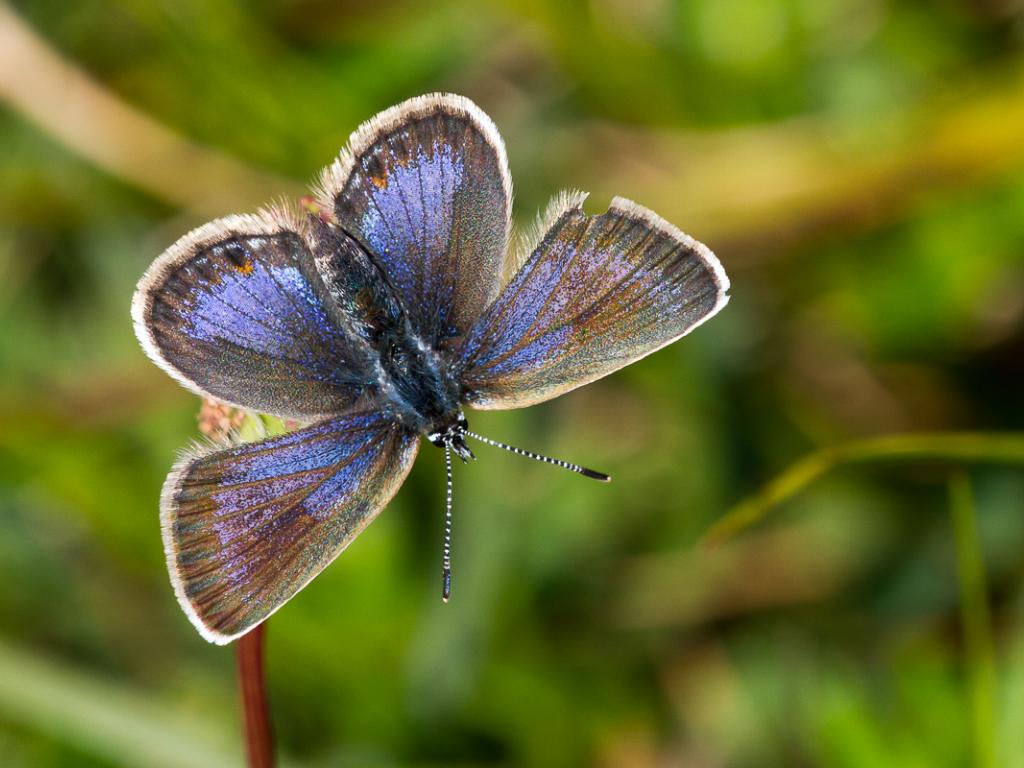
Conservation Status
The Silver-studded Blue is considered rare and has undergone significant declines:
- It’s protected under the UK Wildlife and Countryside Act.
- Listed as a Priority Species in the UK Biodiversity Action Plan.
- Has experienced a 64% distribution decline since the 1970s.
Conservation efforts focus on maintaining suitable habitat through appropriate grazing, controlled burning, and vegetation management.In conclusion, the Silver-studded Blue butterfly is a specialist species with specific habitat requirements and a fascinating relationship with ants. Its restricted distribution and declining populations make it a priority for conservation efforts in the UK.
How does the Silver-studded Blue’s life cycle differ from other butterfly species
The Silver-studded Blue butterfly (Plebejus argus) has some unique aspects to its life cycle compared to other butterfly species:
- Ant association: The Silver-studded Blue has a strong mutualistic relationship with certain ant species, particularly Lasius niger and L. alienus. This relationship is crucial throughout its life cycle:
- Egg-laying: Female butterflies only lay eggs where they detect suitable ant pheromones.
- Larval stage: Caterpillars secrete a sweet substance that attracts ants, which in turn protect the caterpillars from predators.
- Pupation: Caterpillars often pupate within or near ant nests for protection.
- Limited mobility: Silver-studded Blues are extremely sedentary compared to many other butterfly species. Adults rarely fly more than 20 meters from where they emerged. This limited dispersal ability makes them vulnerable to habitat fragmentation.
- Short adult lifespan: Adult Silver-studded Blues typically live only 4-5 days, which is shorter than many other butterfly species.
- Single-brooded: Unlike some butterfly species that have multiple generations per year, the Silver-studded Blue is usually single-brooded, with one generation per year peaking in July.
- Overwintering stage: The species overwinters as eggs, which don’t hatch until the following spring. This differs from some other butterfly species that overwinter as adults or pupae.
- Habitat specificity: Silver-studded Blues are highly habitat-specific, primarily found in heathland and certain types of grassland. This specialization makes them more vulnerable to habitat loss compared to more generalist species.
- Larval food plants: The caterpillars feed on a specific range of plants, including heathers, gorses, and bird’s-foot trefoil, depending on the habitat. This dietary specialization is more restricted than some other butterfly species.
These unique life cycle characteristics, particularly the strong ant association and limited mobility, make the Silver-studded Blue more vulnerable to environmental changes and habitat loss compared to more adaptable butterfly species. This has contributed to its decline and conservation priority status in the UK.
What are the main predators of the Silver-studded Blue butterfly
Based on the search results provided, there is limited specific information about predators of the Silver-studded Blue butterfly. However, we can infer some details about potential predators and the butterfly’s defense mechanisms:
- Ant protection: The Silver-studded Blue has a mutualistic relationship with certain ant species, particularly Lasius niger and L. alienus, which offers protection from predators. The ants guard the butterfly’s eggs, larvae, and pupae against potential threats.
- Other ants: Interestingly, the search results mention that the protective ants guard the Silver-studded Blue larvae against predators, “including other ants”. This suggests that some ant species may prey on the butterfly in its early life stages.
- General insectivores: While not explicitly stated, it’s reasonable to assume that common insectivorous predators of small butterflies could target the Silver-studded Blue. These might include:
- Birds
- Spiders
- Lizards
- Parasitoid wasps (particularly targeting eggs and larvae)
- Defensive adaptations: The butterfly’s close association with ants serves as a primary defense mechanism against predation. Additionally, the species’ sedentary nature and tendency to stay close to the ground may help it avoid detection by some predators.
- Habitat-specific predators: Given that the Silver-studded Blue is found in specific habitats like heathland, sand dunes, and limestone grasslands, it may face predation from animals adapted to these environments.
It’s important to note that the lack of specific information on predators in the search results suggests that predation may not be the primary threat to this species. The butterfly’s conservation status and population declines are more likely due to habitat loss, fragmentation, and specific habitat management requirements.

